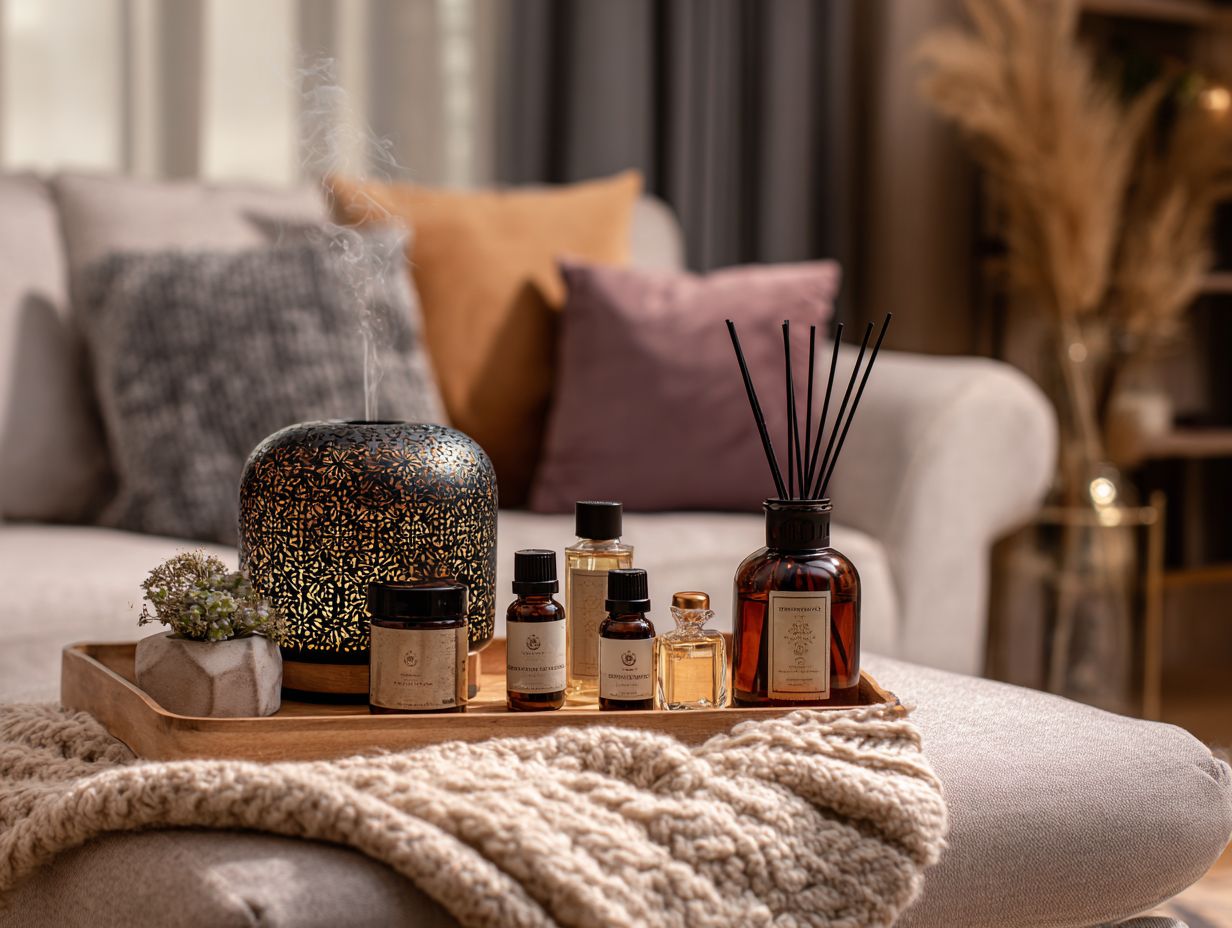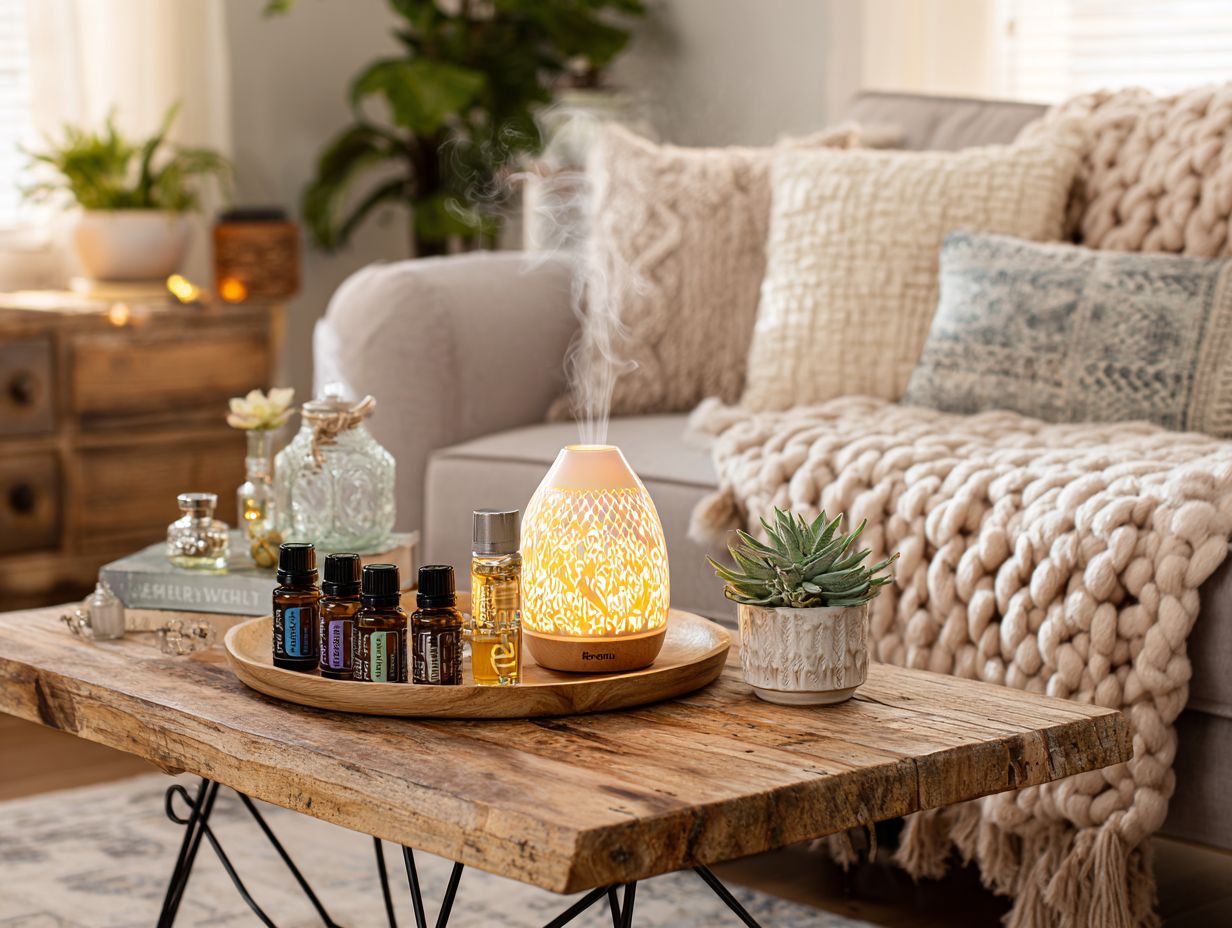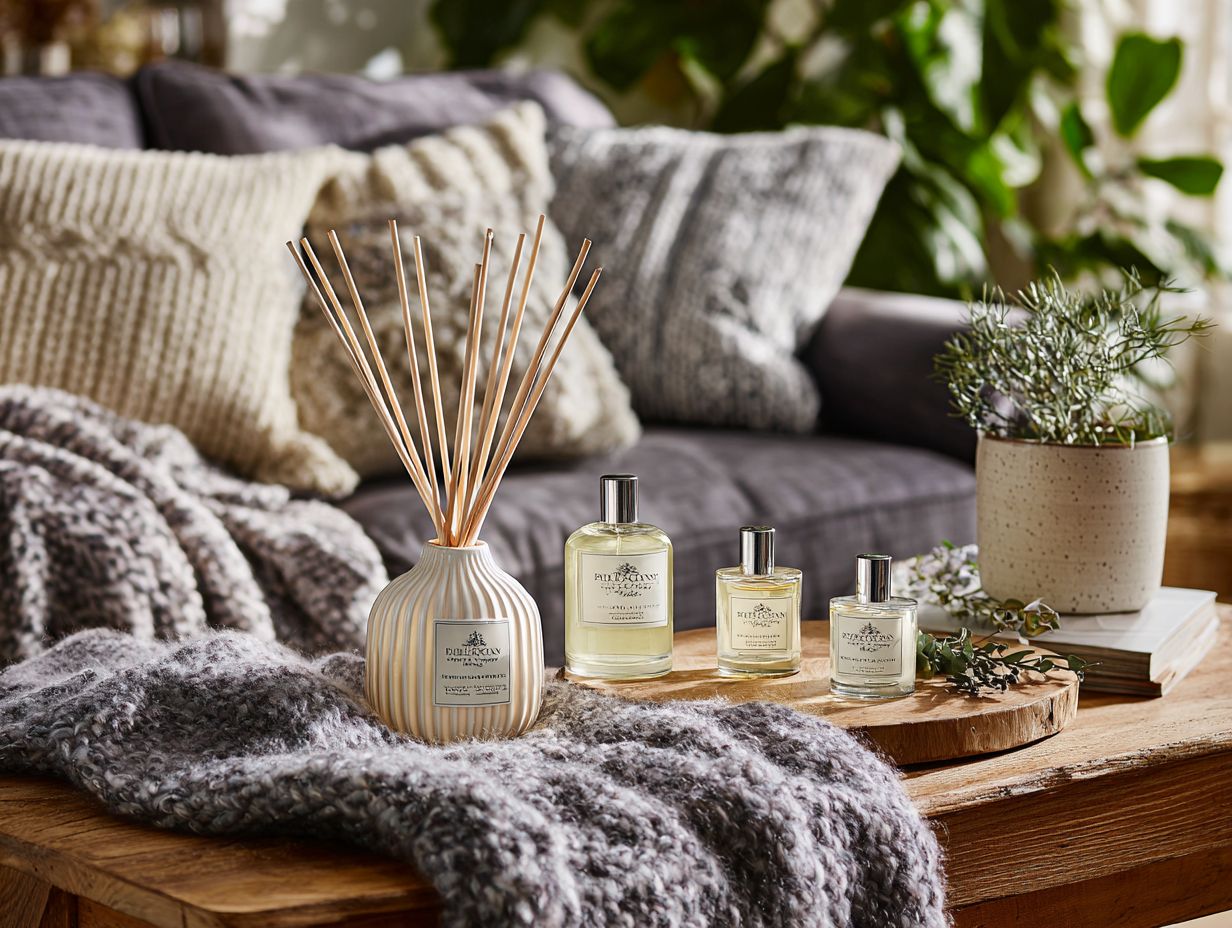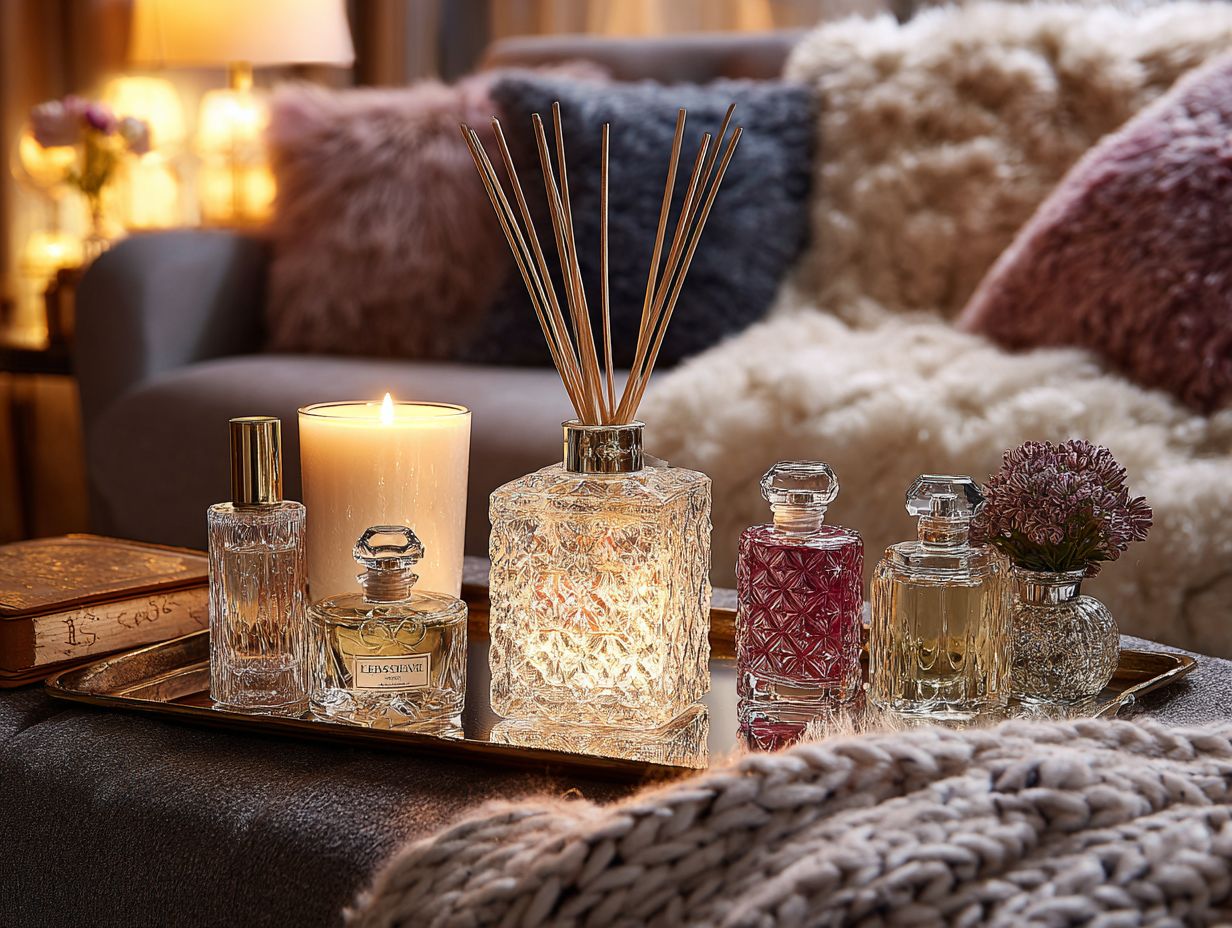Imagine stepping into a room that feels as inviting as a warm embrace, where every breath is filled with carefully curated fragrances designed to enhance your mood. Scentscaping transforms your environment into a sensory haven, allowing you to influence atmosphere, emotional well-being, and interior design with the power of perfume and aroma. In this exploration, I’ll delve into scent selection, effective applications, and DIY solutions, revealing how to create a personalized aromatic experience that resonates with your lifestyle and enhances your home ambiance. Let’s embark on this fragrant journey together!
What is Scentscaping?

Scentscaping is an art that combines fragrance design and scent diffusion techniques to transform spaces.
Scentscaping involves the intentional use of fragrance to create an olfactory environment that enhances the sensory experience of a space, fostering a tranquil environment.
To implement scentscaping effectively, I begin by identifying the key elements within the area. I consider incorporating essential oils, scented candles, and room diffusers in a harmonious manner to craft a layered aroma and improve air quality.
For instance, I can achieve a calming environment by blending lavender for relaxation, citrus for energy, and a hint of sandalwood for grounding. I also find it beneficial to rotate scents seasonally, incorporating seasonal scents like floral notes in spring, to keep the atmosphere fresh and engaging.
Utilizing tools like an ultrasonic diffuser allows for even dispersion of essential oils, while soy candles provide a clean burn and a rich scent profile. This strategic scent layering not only enhances ambiance but also positively influences mood and productivity.
Benefits of Using Scents in Your Environment
Incorporating home fragrance practices can offer substantial aromatherapy benefits.
Incorporating scents into my environment significantly enhances my mood, boosts productivity, and fosters lasting emotional memories, ultimately contributing to my overall well-being and improving home comfort.
I have found that essential oils can be particularly effective in achieving these benefits. For instance, lavender is renowned for its calming properties, which can reduce stress by up to 25%, making it an excellent choice for my workspace. Similarly, citrus scents, such as lemon or orange, can elevate focus and energy levels, potentially increasing productivity by more than 15%.
By utilizing a diffuser throughout my day, I can continuously release these pleasant aromas, providing a backdrop that uplifts my spirit and sharpens my concentration. This creates an inviting environment that is conducive to both personal and professional success.
Choosing the Right Scents
Selecting the right scents requires a thorough understanding of fragrance families and a thoughtful alignment with personal preferences and environmental considerations to achieve optimal impact, enhancing both mood setting and home aesthetics.
Understanding Fragrance Families
Fragrance families encompass floral, citrus, woody, oriental, and spice scents, each characterized by distinct qualities that can significantly influence the ambiance of a space.
For instance, floral scents such as rose or jasmine evoke tranquility, making them ideal for relaxation settings like bedrooms or spas. Citrus fragrances, including lemon and grapefruit, are invigorating and can enhance focus, which makes them particularly suitable for offices or workout areas. Woody scents, such as cedar and sandalwood, create a warm, grounding atmosphere, making them fitting for living rooms or reading nooks.
Meanwhile, oriental fragrances like vanilla and amber are rich and sensual, often enhancing evening settings or romantic dinners.
Selecting the right fragrance family can truly transform the mood and overall experience of any environment.
Personal Preferences vs. Environmental Needs
Balancing my personal scent preferences with the environmental needs of a space is essential for creating a harmonious and effective scentscaping experience. I begin by identifying my primary goals. Am I aiming to energize a workspace, foster a calming atmosphere in the bedroom, or enhance social interactions in a living area?
For example, I find that citrus scents like lemon and orange invigorate and improve focus, making them ideal for office settings. On the other hand, lavender and chamomile are excellent choices when it comes to relaxation.
I also consider using essential oil diffusers for a controlled scent release or scented candles to create a warm ambiance. Evaluating these options allows me to align my personal tastes with the intended mood of each space.
Applications of Perfume in Your Space
I utilize various applications of perfume within my space, such as diffusers, room sprays, and candles, each offering distinct benefits and experiences.
Diffusers and Scent Machines

Ultrasonic diffusers, like the URPOWER 1000ml Essential Oil Diffuser priced at $32.99, are highly effective in dispersing essential oils into the air, resulting in a consistent scent experience and improving scent diffusion.
These devices utilize a combination of water and essential oils, employing vibrations to create a fine mist.
For optimal results, I recommend selecting high-quality oils, such as lavender for relaxation or peppermint for an energy boost.
Popular models, including the InnoGear Diffuser at $29.99 and the VicTsing 500ml Diffuser at $39.99, provide varied run times and LED lighting features to enhance the user experience.
To maximize the spread of aroma, I place the diffuser in a central location and ensure it is regularly cleaned to prevent buildup. Additionally, I pair my diffusion practice with essential oils known for their specific benefits, such as eucalyptus for promoting clear breathing.
Room Sprays and Mists
Room sprays like Poo-Pourri ($9.99) provide an excellent solution for an instant fragrance boost, making them ideal for quick scent fixes in various environments, including homes and offices.
To maximize the effectiveness of room sprays, I find that timing and placement are essential. It’s best to use them before guests arrive or after cooking to effectively neutralize any lingering odors. For optimal results, I make sure to spray toward the center of the room, allowing the fragrance to disperse evenly throughout the space.
For those who prefer a DIY approach, I recommend creating a custom blend using the following ingredients:
- 1 cup of distilled water
- 2 tablespoons of vodka (which aids in better dispersion)
- 10-15 drops of your chosen essential oil, such as lavender or citrus
I always remember to shake the mixture before each use to achieve an invigorating aroma that truly personalizes my environment.
Scented Candles and Incense
I find that scented candles, such as the Yankee Candle Large Jar priced at $29.99, can significantly enhance the ambiance of a space while offering therapeutic benefits through thoughtfully curated scents, contributing to an overall holistic scents experience.
For example, lavender is well-regarded for its ability to promote relaxation, making it an ideal choice for calming evenings. If I’m seeking focus and clarity, I prefer citrus scents like lemon or grapefruit, which can invigorate my workspace.
When using candles, I always ensure they are placed on heat-resistant surfaces and avoid leaving them unattended. I also choose sustainable brands like Beeswax Co. or Pure Plant Home, as they prioritize eco-friendly materials and practices.
Additionally, incorporating essential oil-infused incense, such as those from Satya, allows me to add aromatic depth while enhancing my personal sanctuary.
Creating Atmosphere with Scents
I recognize that creating an atmosphere with scents requires a deep understanding of how various fragrances can enhance mood, productivity, emotional well-being, and home wellness.
Enhancing Mood and Productivity
I have found that certain scents, such as peppermint and citrus, can significantly enhance mood and productivity in workplace settings, ultimately leading to improved performance. To incorporate these scents effectively, I consider using essential oil diffusers or scented candles in my workspace.
For example, adding a few drops of peppermint essential oil can invigorate my environment, making it particularly conducive for tasks that require focus. Additionally, citrus scents like lemon or orange are excellent for uplifting spirits; I often use a citrus-scented candle during morning meetings to energize the team.
I also find that personal inhalers or roll-on essential oils provide a quick boost whenever needed. By regularly integrating these scents into my routine, I can foster a more positive and productive atmosphere.
Seasonal Scents for Different Times of the Year
Utilizing seasonal scents, such as cinnamon in the fall or floral notes in the spring, allows me to create a welcoming and festive atmosphere in my home, enhancing both home scents and scent rituals.
For a truly immersive experience, I consider the following recommendations:
- In spring, fresh scents like jasmine and peony enhance the vibrant bloom of nature.
- Summer benefits from citrus fragrances like lemon and bergamot, which brighten the spaces.
- As fall arrives, I embrace rich, warm notes such as pumpkin spice and nutmeg, perfect for cozy gatherings.
- Winter calls for soothing scents like cedarwood and peppermint, evoking comfort during chilly nights.
I find that using essential oils in diffusers, candles, or potpourri helps me seamlessly integrate these scents into my decor throughout the year.
DIY Scentscaping Solutions

I find that DIY scentscaping offers a unique opportunity to create personalized fragrances utilizing natural ingredients. This approach not only allows for significant cost savings but also fosters creativity in the scent design process, allowing for personalized scent experiences.
Homemade Room Sprays
Creating homemade room sprays with essential oils, such as lavender and eucalyptus, is an enjoyable and cost-effective method to refresh my living space and enhance indoor scents.
To prepare my own room spray, I gather the following ingredients:
- 1 cup of distilled water
- 2 tablespoons of vodka or rubbing alcohol
- 15-20 drops of my chosen essential oil
For a soothing lavender scent, I combine 15 drops of lavender with 5 drops of bergamot, creating a tranquil scents experience. Alternatively, if I prefer a revitalizing eucalyptus scent, I mix 15 drops of eucalyptus with 5 drops of mint for an energy boosting effect.
Once I have these ingredients, I simply combine them in a spray bottle, shake well, and then spritz throughout my home to create an aromatic atmosphere, transforming the space with natural scents.
Natural Ingredients for Scented Spaces and Fragrance Infusion
I have found that utilizing natural ingredients, such as citrus peels and herbs, significantly enhances the aroma of my space while promoting a healthier indoor environment.
To create my own scented oils, I combine one cup of a carrier oil, such as olive or almond oil, with zest from oranges, lemons, or fresh herbs like basil and rosemary, embracing the use of eco-friendly scents.
I allow the mixture to sit in a warm spot for a week, shaking it daily to infuse the scents fully.
For potpourri, I mix dried flowers with cinnamon sticks, cloves, and dried citrus slices, placing them in an open bowl to release their natural fragrances, enhancing the room with scent and environment.
These DIY methods not only transform any room into a fragrant haven but also help me avoid synthetic fragrances.
Maintaining Your Scentscaping and Scented Decor
Maintaining my scentscaping requires regular refreshing and careful selection of fragrances to ensure that the environment remains balanced and inviting, without becoming overpowering.
How to Refresh Scents Over Time
I regularly refresh my scents by changing out candles and oils every few weeks to ensure a consistently pleasant atmosphere. To maintain a vibrant scent experience, I pay attention to the type of application I use.
For candles, I make it a point to replace them every 3-4 weeks or as soon as the scent begins to weaken. With essential oil diffusers, I find that refilling them weekly yields the best fragrance results.
In terms of potpourri, I refresh it on a monthly basis by adding a few drops of essential oil to revive its scent. In high-traffic areas, I prefer using air freshener sprays for quick bursts of aroma as needed.
Each of these methods requires minimal time investment and can significantly enhance the ambiance of my home.
Avoiding Overpowering Fragrances and Promoting Scent Harmony
To maintain an inviting atmosphere, I understand the importance of balancing scents to ensure they enhance the space rather than overwhelm it. I begin by measuring scent intensity with a simple test: I light a candle or use a diffuser in a smaller area first and closely monitor how the fragrance develops over time.
If I find the scent to be overpowering, I reduce the number of sources or opt for unscented options periodically. I also utilize a scent intensity scale-from subtle to strong-to assist in selecting the appropriate level for my needs.
By combining complementary notes, such as lavender with citrus, I can create a harmonious blend that elevates the mood without being intrusive, embarking on an olfactory journey.
Embracing a Scented Lifestyle and Multi-Sensory Experiences

Adopting a scented lifestyle has the potential to transform my daily routines, making each moment more enjoyable and significantly enhancing my living environment, contributing to sensory environments.
To effectively incorporate scents into my life, I begin by identifying oils or candles that resonate with me. For instance, I find that lavender promotes relaxation, while citrus scents can boost my energy and focus.
I utilize tools like essential oil diffusers or scented candles to disperse these aromas throughout my home, participating in ambient scenting. A diffuser with a timer feature is particularly beneficial as it helps create a calming atmosphere during activities such as meditation or reading.
Additionally, I enjoy blending oils to create bespoke fragrances, enriching my surroundings while personalizing my experience. This approach allows me to embrace a holistic perspective on well-being.
Frequently Asked Questions on Scent Personalization
What is scentscaping and how can it be used beyond the body?
Scentscaping is the art of using different scents to create a specific ambiance in a space. It can be used beyond the body by incorporating perfume in various ways to enhance the overall atmosphere.
How can I incorporate perfume in my home to create a unique scentscape and olfactory art?
You can use perfume by spraying it on fabrics such as curtains, pillowcases, or even on decorative items like potpourri. You can also use diffusers or scented candles to infuse the space with your favorite scent.
What are some tips for scentscaping my workspace or office?
You can use uplifting scents such as citrus or peppermint to increase productivity and focus. You can also use warm and comforting scents like vanilla or cinnamon to create a welcoming atmosphere for clients or customers.
Can scentscaping help in improving the overall mood of a space?
Yes, the right scent can have a significant impact on the mood of a space. For example, using lavender can promote relaxation and create a calming environment, while using a bright citrus scent can boost energy and positivity.
How can I use perfume to scentscape for special occasions or events?
For special occasions, you can use scents to create a specific theme or mood. For a romantic dinner, use a sensual musk scent, or for a festive party, use a warm and inviting scent like cinnamon or pine.
Can I create a personalized scentscape for my home using different perfumes?
Absolutely! You can mix and match different scents to create a unique fragrance that reflects your personality and style. You can also layer scents by using different perfumes in different areas of your home to add depth to your scentscape.


